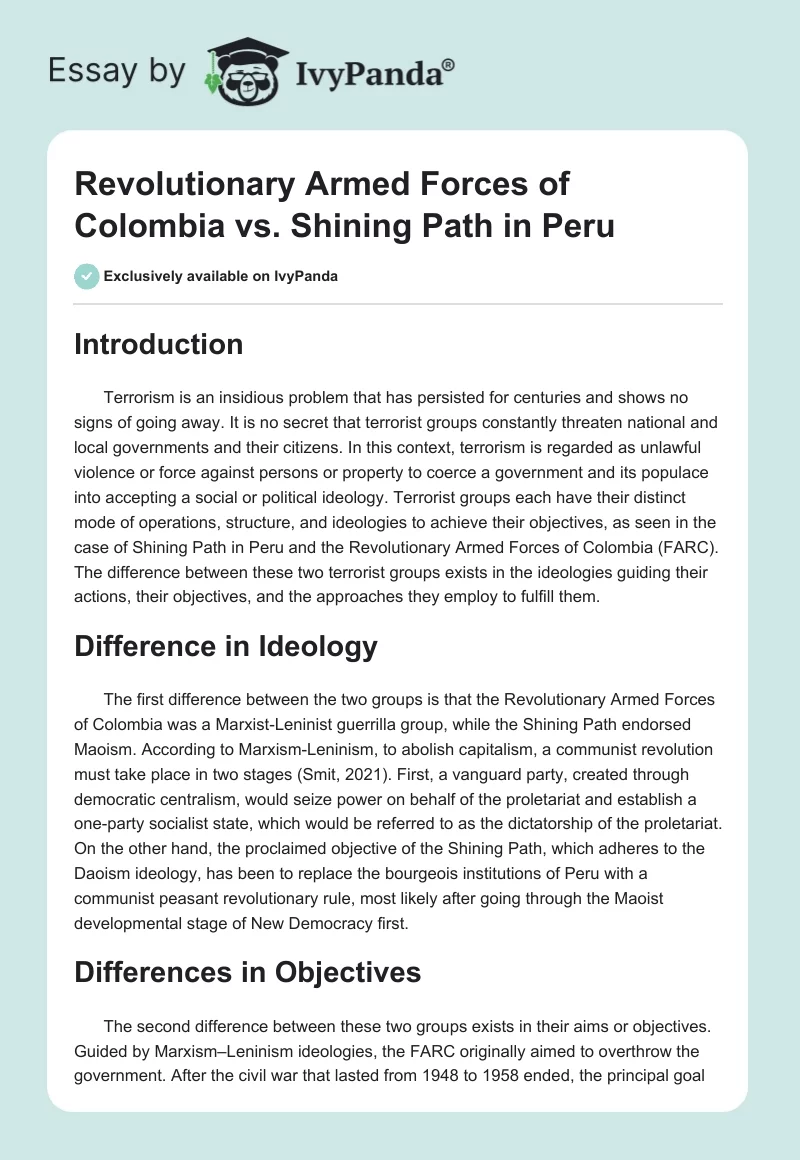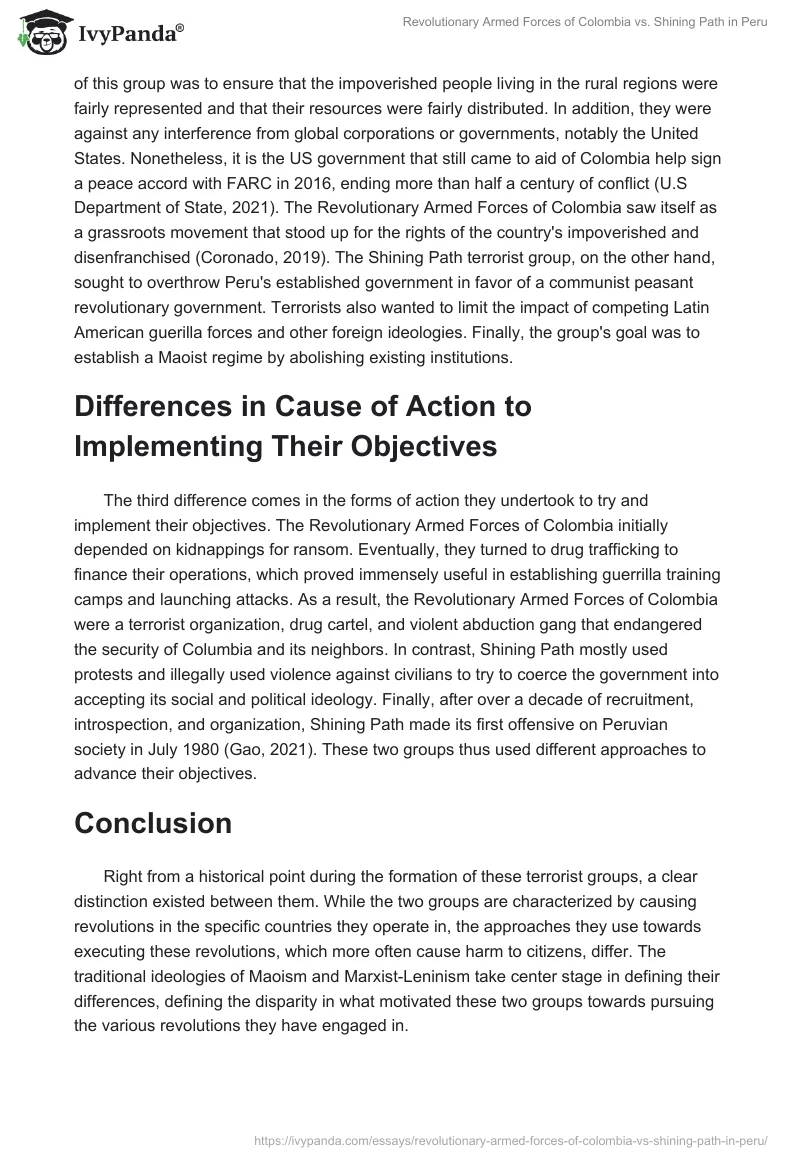Introduction
Terrorism is an insidious problem that has persisted for centuries and shows no signs of going away. It is no secret that terrorist groups constantly threaten national and local governments and their citizens. In this context, terrorism is regarded as unlawful violence or force against persons or property to coerce a government and its populace into accepting a social or political ideology. Terrorist groups each have their distinct mode of operations, structure, and ideologies to achieve their objectives, as seen in the case of Shining Path in Peru and the Revolutionary Armed Forces of Colombia (FARC). The difference between these two terrorist groups exists in the ideologies guiding their actions, their objectives, and the approaches they employ to fulfill them.
Difference in Ideology
The first difference between the two groups is that the Revolutionary Armed Forces of Colombia was a Marxist-Leninist guerrilla group, while the Shining Path endorsed Maoism. According to Marxism-Leninism, to abolish capitalism, a communist revolution must take place in two stages (Smit, 2021). First, a vanguard party, created through democratic centralism, would seize power on behalf of the proletariat and establish a one-party socialist state, which would be referred to as the dictatorship of the proletariat. On the other hand, the proclaimed objective of the Shining Path, which adheres to the Daoism ideology, has been to replace the bourgeois institutions of Peru with a communist peasant revolutionary rule, most likely after going through the Maoist developmental stage of New Democracy first.
Differences in Objectives
The second difference between these two groups exists in their aims or objectives. Guided by Marxism–Leninism ideologies, the FARC originally aimed to overthrow the government. After the civil war that lasted from 1948 to 1958 ended, the principal goal of this group was to ensure that the impoverished people living in the rural regions were fairly represented and that their resources were fairly distributed. In addition, they were against any interference from global corporations or governments, notably the United States. Nonetheless, it is the US government that still came to aid of Colombia help sign a peace accord with FARC in 2016, ending more than half a century of conflict (U.S Department of State, 2021). The Revolutionary Armed Forces of Colombia saw itself as a grassroots movement that stood up for the rights of the country’s impoverished and disenfranchised (Coronado, 2019). The Shining Path terrorist group, on the other hand, sought to overthrow Peru’s established government in favor of a communist peasant revolutionary government. Terrorists also wanted to limit the impact of competing Latin American guerilla forces and other foreign ideologies. Finally, the group’s goal was to establish a Maoist regime by abolishing existing institutions.
Differences in Cause of Action to Implementing Their Objectives
The third difference comes in the forms of action they undertook to try and implement their objectives. The Revolutionary Armed Forces of Colombia initially depended on kidnappings for ransom. Eventually, they turned to drug trafficking to finance their operations, which proved immensely useful in establishing guerrilla training camps and launching attacks. As a result, the Revolutionary Armed Forces of Colombia were a terrorist organization, drug cartel, and violent abduction gang that endangered the security of Columbia and its neighbors. In contrast, Shining Path mostly used protests and illegally used violence against civilians to try to coerce the government into accepting its social and political ideology. Finally, after over a decade of recruitment, introspection, and organization, Shining Path made its first offensive on Peruvian society in July 1980 (Gao, 2021). These two groups thus used different approaches to advance their objectives.
Conclusion
Right from a historical point during the formation of these terrorist groups, a clear distinction existed between them. While the two groups are characterized by causing revolutions in the specific countries they operate in, the approaches they use towards executing these revolutions, which more often cause harm to citizens, differ. The traditional ideologies of Maoism and Marxist-Leninism take center stage in defining their differences, defining the disparity in what motivated these two groups towards pursuing the various revolutions they have engaged in.
References
Coronado, S. (2019). Rights in the time of populism: land and institutional change amid the reemergence of right-wing authoritarianism in Colombia. Land, 8(8), 119. Web.
Gao, J. (2021). Causing troubles elsewhere: the Shining Path and its international networks, 1980-1993. Asian Journal of Latin American Studies, 34(1), 49-75. Web.
Smit, P. S. (2021). A presuppositional analysis of key concepts of the worldview of the South African Communist Party (Doctoral dissertation, North-West University (South-Africa). Web.
U.S Department of State, (2021) U.S. relations with Colombia: bilateral relations factsheet. Bureau of Western Hemisphere Affairs. Web.


